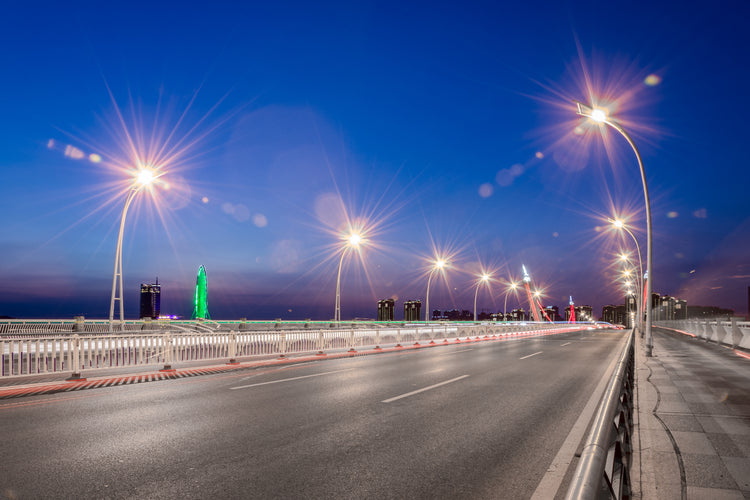From its early conceptual stages to its present-day prominence, solar powered LED lighting has evolved from a niche solution to an indispensable technology in modern commercial spaces. Initially, both solar energy and LED lighting were seen as emerging innovations with limited applications. Solar power was primarily used in off-grid areas, while LEDs were mostly found in small-scale uses, such as indicator lights. However, as both technologies advanced over the decades, they converged to offer a powerful, eco-friendly lighting alternative. Today, solar powered LED lighting is no longer a mere trend but a cornerstone of energy-efficient commercial solutions, the detailed information of which you are going to read in this blog post!
Historical Background
Solar powered LED lights are the product of two technologies that were once isolated in their own developmental silos—solar energy and light-emitting diodes (LEDs). Here’s how they converged over time to revolutionize modern lighting: -
- Solar Energy Origins
The first practical solar cell was developed back in 1954 by Bell Laboratories. But here’s a shocker—it could only convert about 6% of sunlight into energy. Early solar technology wasn’t exactly ready to light up the neighbourhood.
- The LED Breakthrough
LEDs debuted in the 1960s as simple red indicator lights. Fast-forward to the 2000s, engineers cracked the code on creating brighter, more versatile LEDs in various colors. Add energy efficiency to the mix, and LEDs became a top pick for everything from flashlights to traffic signs.
Key Milestones in the Evolution of Solar Powered LED Lighting
A lot had to happen for solar powered LEDs to become the powerhouse lighting systems we know today. Here are some key milestones that pushed this technology forward:
1. The First Solar Streetlights
In the 1990s, solar streetlights emerged as a pioneering solution for rural and off-grid areas with limited access to traditional power grids. These early systems utilized photovoltaic (PV) panels to convert sunlight into electricity, which was stored in lead-acid batteries for nighttime use. While they offered an eco-friendly alternative to conventional lighting, they had significant drawbacks. The lead-acid batteries were large, heavy, and prone to frequent degradation, requiring costly replacements and high maintenance. Despite these challenges, the introduction of solar streetlights marked an essential step in the evolution of renewable energy applications, highlighting the potential of solar power for public infrastructure.
2. Integration of Lithium-Ion Batteries
The early 2000s witnessed a transformative shift in solar lighting technology with the adoption of lithium-ion batteries. These batteries revolutionized solar powered systems by offering superior energy density, lightweight construction, and significantly longer lifespans compared to their lead-acid counterparts. Lithium-ion technology also provided greater reliability by storing more energy and delivering consistent performance, even in areas with limited sunlight. This advancement dramatically reduced the maintenance requirements and costs associated with solar lighting, making it more feasible for widespread adoption in both urban and rural settings.
3. Smart Solar Lighting Systems
By 2010, the incorporation of automation into solar lighting systems brought about a new era of efficiency and adaptability. These "smart" systems featured advanced sensors and programming that allowed lights to adjust their brightness based on environmental conditions or activity levels. For instance, motion sensors enabled lights to brighten when detecting movement and dim during periods of low traffic, conserving energy without sacrificing functionality. Other systems included sensors to adapt to ambient light or weather conditions, further optimizing performance. Smart solar lighting reduced energy consumption, extended battery life, and enhanced sustainability, making it a preferred solution for modern urban planning and infrastructure projects.
4. Solar + IoT (Internet of Things)
By the late 2010s, solar powered LED lighting integrated with the Internet of Things (IoT), bringing unparalleled control and efficiency. IoT-enabled systems allowed for remote monitoring and management, enabling city planners and businesses to track energy usage, detect malfunctions, and schedule maintenance in real-time. Predictive maintenance features minimized downtime and extended the lifespan of lighting components, while data-driven insights helped optimize energy usage and costs. These innovations played a critical role in the development of smart cities, where interconnected solar lighting systems improved sustainability and streamlined energy management across large-scale infrastructure, such as highways, industrial parks, and urban streets.
5. Introduction of Circadian-Optimized Lighting (2010s)
In the early 2010s, circadian rhythm—our internal biological clock regulating sleep-wake cycles—gained significant traction in the health sector. Solar powered LEDs were at the forefront of this development, offering a solution to maintain healthy circadian rhythms. These LEDs, with their tunable capabilities, mimic the changing patterns of natural sunlight, adjusting their color temperature and intensity throughout the day. This innovation became widely adopted in healthcare facilities. These solar powered LEDs promote better sleep, mood, and productivity by optimizing light exposure, supporting overall LED Lighting for Health and Wellbeing.
Current Applications of Solar Powered LED Lighting in Commercial Spaces
Alright, now it’s time to get practical. Wondering how solar powered LEDs fit into commercial spaces? Check out where businesses are using them today:
1. Outdoor Lighting
From expansive parking lots to striking building façades, solar-powered LED lights provide consistent, reliable illumination throughout the night, making them an ideal outdoor lighting solution for better security while drastically reducing energy consumption. With their durability and ability to function independently of the power grid, they are becoming a staple for forward-thinking enterprises.
2. Signage and Advertisement Displays
Traditional billboards and neon signs are gradually being replaced with energy-efficient, solar-powered LEDs. Why? The benefits are undeniable. These lights not only lower operating costs but also ensure that advertisements shine bright night after night—without breaking the bank. For businesses aiming to keep the spotlight on while cutting expenses, this technology delivers both visibility and value. Network Lighting Controls offer the additional advantage of remotely controlling multiple signboards or advertisements for improved efficiency and sustainability.
3. Warehouses and Factories
Inside industrial spaces like warehouses and factories, solar powered LED panels are becoming a favorite. These systems significantly reduce electricity costs while emitting minimal heat, creating a more efficient and comfortable work environment. The transition toward solar powered LED lights also aligns with broader sustainability goals, showcasing a commitment to eco-conscious operations.
4. Garden and Landscape Lighting
For hotels, office complexes, and retail spaces, solar lights for the outdoors are an excellent choice for aesthetic lighting. They beautifully highlight pathways, gardens, and architectural elements, adding elegance and charm to outdoor spaces—all while keeping utility costs low. By combining functionality with visual appeal, these lights enable businesses to enhance their external ambiance
Benefits of Solar-Powered LED Lighting for Commercial Use
Many businesses are adopting solar LED lighting systems, and the reasons extend beyond environmental sustainability. Here is a comprehensive overview of the key advantages behind this transition.
1. Energy Savings
Solar-powered LEDs draw energy from the sun. Combine that with the efficiency of LEDs, and businesses can reduce their electricity bills significantly. Talk about a win-win!
2. Environmentally Friendly
Going solar helps reduce carbon footprints. Every watt of solar energy generated replaces energy that would've been produced using fossil fuels. For businesses looking to champion sustainability, this is a huge plus.
3. Low Maintenance Costs
The long lifespan of LEDs (lasting 25,000–50,000 hours!) reduces the need for frequent replacements. Plus, modern solar solutions come with durable batteries, meaning you save on maintenance costs, too.
4. Energy Independence
Businesses using solar-powered lighting are less reliant on the traditional power grid. This can help in areas prone to power outages or fluctuating electricity costs.
5. Tax Credit Incentives
Many countries offer tax incentives and rebates for businesses adopting solar technology. These incentives effectively bring down the initial investment costs.
6. Brand Reputation
Consumers are increasingly favoring eco-conscious businesses. Switching to solar isn’t just smart for your bottom line but also great for your brand image. It shows your company values sustainable practices.
Challenges and Considerations
Location and Sunlight Exposure
One of the primary factors in solar lighting is the location where the system is installed. Areas with limited direct sunlight due to shading from nearby buildings or trees can affect the system's efficiency. To overcome this, careful site analysis is needed before installation that make sure the solar panels receive optimal sunlight, maximizing energy production.
Battery Performance and Storage
While battery storage is integral for powering lights during the night or cloudy days, battery degradation over time can affect the system's performance. Improving battery life and efficiency remains a key area for solar powered systems. Upgrading to higher-quality, long-lasting batteries could help address this challenge.
Customization for Different Applications
Commercial solar lighting needs to be tailored to different environments, such as parking lots, streets, or pathways, each requiring different lighting levels and uniformity. Without a customized approach, businesses may face under- or over-illuminated spaces, leading to energy inefficiencies or reduced effectiveness.
System Costs and Initial Investment
While solar lighting systems promise long-term cost savings, the upfront investment can be significant. This can be a barrier for many businesses looking to switch to renewable energy. A more affordable, flexible pricing model or incentives for adopting solar technology could improve adoption rates.
Technology Integration
The integration of advanced features such as motion sensors, dimming capabilities, and dark-sky-friendly designs could enhance the energy efficiency of solar powered LED systems. However, these features still need to be optimized to reduce initial costs while improving energy-saving
Future Trends in Solar Powered LED Lighting
Wondering what’s next for solar powered LEDs? Here are the top future trends that one should look forward to:
1. More Efficient Solar Panels
Advances in photovoltaic (PV) technology are a key driver of change. For example, innovations like bifacial solar panels, which capture light from both sides, are poised to improve the energy efficiency of solar lighting. This means solar powered LEDs could perform better in areas with lower sunlight, making them viable for more locations.
2. Wireless Integration
As technology evolves, solar powered LEDs are becoming more streamlined, with wireless integration becoming a significant trend. Wireless systems eliminate the need for wiring, simplifying installation and enabling flexible placement of lights. This is particularly beneficial for both residential and commercial setups.
3. Integration with Renewable Microgrids
Solar LED lighting is increasingly being integrated into renewable microgrids, which are small-scale power systems that use local renewable energy sources. This integration helps reduce reliance on fossil fuels, promoting more sustainable urban energy solutions. Cities are leveraging solar powered LEDs as part of broader smart city initiatives aimed at enhancing efficiency and reducing carbon footprints.
4. 3D Printing Solar LEDs
The use of 3D printing is opening up possibilities for customized, on-demand solar lighting solutions. This technology allows for the creation of unique, tailored solar-powered LED lights to fit specific business needs, whether in public spaces or private properties. Companies are exploring how this innovation can support diverse design preferences and applications
5. Energy Sharing Across Buildings
In the future, commercial buildings may be able to share energy storage systems, enhancing the efficiency of solar lighting across multiple structures. By pooling energy resources, businesses can lower their energy costs and maximize the use of solar power, particularly in areas with abundant sunlight.
In a Nutshell
With countless benefits, including energy savings, low maintenance, and reduced environmental impact, it’s no wonder that businesses are switching towards solar lights. However, making an informed choice about the right solar lighting system is crucial for guaranteeing optimal performance and return on investment. At Maverick LED, we have a wide range of high-quality solar products, from retail to industrial. We can help you find the perfect lighting solution for you. Whether you're looking to brighten up a commercial space or integrate solar lighting into your larger sustainability goals, our expert team is here to assist you every step of the way.


